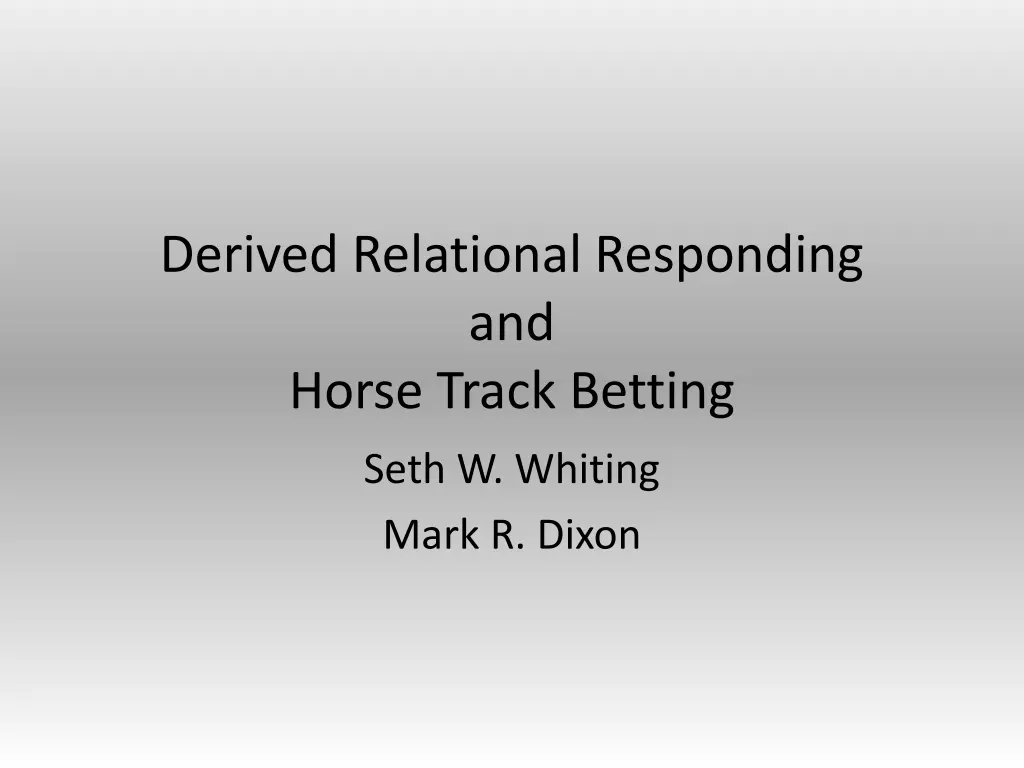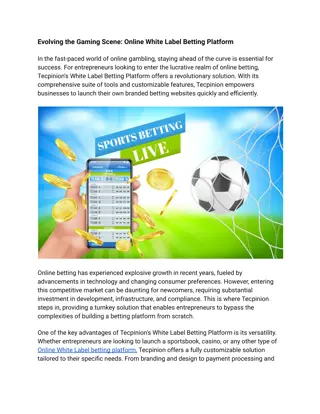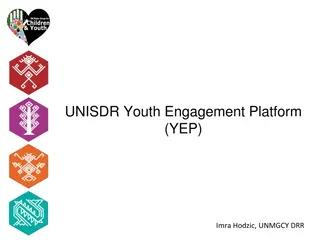
Relational Responding in Horse Track Gambling Studies
Explore the influence of relational responding on horse track betting and gambling behaviors, examining statistics on American gambling habits, horse racing consumer spending, and factors affecting horse gambling choices. Learn about the transformation of function in stimulus control and discrimination training in these contexts, including insights from studies conducted by researchers like Seth W. Whiting, Mark R. Dixon, and more.
Download Presentation

Please find below an Image/Link to download the presentation.
The content on the website is provided AS IS for your information and personal use only. It may not be sold, licensed, or shared on other websites without obtaining consent from the author. If you encounter any issues during the download, it is possible that the publisher has removed the file from their server.
You are allowed to download the files provided on this website for personal or commercial use, subject to the condition that they are used lawfully. All files are the property of their respective owners.
The content on the website is provided AS IS for your information and personal use only. It may not be sold, licensed, or shared on other websites without obtaining consent from the author.
E N D
Presentation Transcript
Derived Relational Responding and Horse Track Betting Seth W. Whiting Mark R. Dixon
Gambling The National Council of Problem Gambling suggested that upwards of 80 percent of American residents have gambled once or more in their life (2011). Further, approximately 2.3 percent of the general population engage in problem gambling (Kessler et al., 2008).
Horse Racing Consumer spent approximately $6.4 billion at racetrack casinos in 2009 This reflects an increase of 5% since 2008 As of 2010, there are 44 racetrack casinos throughout 12 states (American Gaming Association) Casino Games Racetrack Facilities (Dunstan, 1997)
Influences on Horse Gambling Choices based on formal properties Would you gamble on Horse 1 Horse 2
Horses at the Kentucky Derby All look similar Other features: names, colors, jockey colors
Transformation of Function Transformation: in the absence of direct training, a stimulus can acquire a function through inclusion in a stimulus class or relation(Dougher, Perkins, Greenway, Koons, & Chiasson, 2002) Rehfeldt & Hayes (1998) examined this phenomenon with untrained temporal differentiation
Rehfeldt & Hayes (1998) Participants responded on a conjunc FR5 t < IRT < t reinforcement schedule Stimuli were placed in a class via conditional discrimination training Participants clicked on novel stimuli with the same temporal responses, despite the lack of training Responding can come under discriminative temporal control via transformation of function
Dixon, Wilson, & Whiting (in press) Extended these findings to a horse track gambling context Participants were trained to respond to stimuli on conjunc FR5 t < IRT < t reinforcement schedule When placed in an equivalence class with a colored square, participants increased bet allocation to horse of the color requiring clicking on the lowest IRT No direct training
Dixon, Wilson, & Whiting (in press) However, betting was between 8 colored horses, and only 3 were included in conditional discrimination training Resulting in inconsistent changes and some increases on medium and slow horse Mastery on equivalence test was not required Participants were inexperienced gamblers (SOGS 0-2)
Current Study Seek to extend the previous studies by Examining the transformation of function on a simulated horse track Using Problem/Pathological gamblers as participants Controlled betting- 2 horses only Require demonstration of equivalence relation
Participants and Setting Participants included 3 undergraduate students from Southern Illinois University Procedures completed on campus in a lab setting on a desktop computer Simulated horse track was created using Microsoft Visual Studio 2008
Participants Average age: 20.67 (20-21) All Male, income <5000, single, no children Mean SOGS score: 4.67 (4-6)
Horse Track Pre-Test Participants bet up to 10 hypothetical credits per trial This phase lasted for 10-30 trials, randomly selected by computer Nonconcurrent multiple baseline Random outcomes
Video of horse race Notes: Orange and purple horses were each programmed to win for sure on 30% of trials 70% of trials had random outcome All horses speed up or slow down several times 1/8 chance to win- all horses pay 8X bet
Pretraining One of two random stimuli was presented. Participants had to respond on an FR-5 schedule to earn reinforcement across 15 trials. Stimuli were not used at any other time
Conjunc FR 5 t1 < IRT < t2 Training and Testing A1 Conjunc FR 5 0.0 < IRT < 0.5 A3 Conjunc FR 5 1.5 < IRT < 3.0
Conjunc FR 5 t1 < IRT < t2 Training and Testing Participants were required to click on A1 and A3 stimuli for 15 successful trials each. The stimuli were then presented randomly for 16 trials to test the trained functions. 13/16 to pass
Match-to-Sample A-B and B-C relations were trained individually and mixed. Reflexivity A-A B-B C-C Symmetry B-A C-B Transitivity A-C Equivalence C-A
Stimuli 1 2 3 A B C RIW DAX QAF
A-B B-C Mixed A-B, B-C Refl. A-A, B-B, C-C Sym. B-A, C-B Trans. A-C Equiv. C-A Criterion: 16/18 Feedback: Yes
A-B B-C Mixed A-B, B-C Refl. A-A, B-B, C-C Sym. B-A, C-B Trans. A-C Equiv. C-A Criterion: 16/18 Feedback: Yes
A-B B-C Mixed A-B, B-C Refl. A-A, B-B, C-C Sym. B-A, C-B Trans. A-C Equiv. C-A Criterion: 32/36 Feedback: Yes
A-B B-C Mixed A-B, B-C Refl. A-A, B-B, C-C Sym. B-A, C-B Trans. A-C Equiv. C-A Criterion: none Feedback: no
A-B B-C Mixed A-B, B-C Refl. A-A, B-B, C-C Sym. B-A, C-B Trans. A-C Equiv. C-A Criterion: none Feedback: no
A-B B-C Mixed A-B, B-C Refl. A-A, B-B, C-C Sym. B-A, C-B Trans. A-C Equiv. C-A Criterion: none Feedback: no
A-B B-C Mixed A-B, B-C Refl. A-A, B-B, C-C Sym. B-A, C-B Trans. A-C Criterion: 15/18 Feedback: No If failed: back to Mixed Equiv. C-A
Horse Track Post-Test Betting was again measured over 31-60 trials on the horse track Number of trials was again selected at random
Results Discrimination Training Discrimination Testing Mixed A-B/B-C Training (trial blocks to criterion) 1 Temporal Testing (trial blocks to criterion) 1 A-B B-C Training (trial blocks to criterion) 1 Training (trial blocks to criterion) 2 Reflexivity (%) 100 Symmetry (%) 100 Transitivity (%) 100 Equivalence (%) 100 Participant 1 2 2 2 2 1 100 100 88.9 100 3 2 6 14 2 100 100 100 100 *Participant 2 failed equivalence testing once, participant 3 failed twice. Testing scores reflect the percent correct when criterion was met
Results All participants passed temporal testing in 1-2 trial blocks Participants 2 and 3 failed equivalence testing, but finished with 100% accuracy when they met criterion
10 9 8 7 6 5 4 3 2 1 0 Avg. bet per 5 race trial Block 1 2 3 4 5 6 7 8 9 10 11 12 13 14 10 9 8 7 6 5 4 3 2 1 0 1 2 3 4 5 6 7 8 9 10 11 12 13 14 10 9 8 7 6 5 4 3 2 1 0 1 2 3 4 5 6 7 8 9 10 11 12 13 14
Betting Summary +8.46% +0.93% +17.66% Percentage of Credits Bet on the Fast Horse 70 60 50 40 Pre-Test 30 Post-Test 20 10 0 1 2 3 Participant
Betting Results All participants increased betting on the fast horse Participant 2 changed bets minimally Reported that the odds were likely even
Discussion Results were consistent Change maintained throughout all trials following training Scores on equivalence test showed the presence of established equivalence classes and derived relations Post-training gambling allocation suggests that the color of the horse with formal similarity to the C stimuli in relational training acquired the function of faster than
Discussion Arbitrary stimuli acquired functions through differential reinforcement, and those functions transformed to other stimuli placed in the same class The results provide evidence that verbal behavior plays an important role in gambling The word faster or slower were never mentioned, functions were acquired through clicking rate only






















